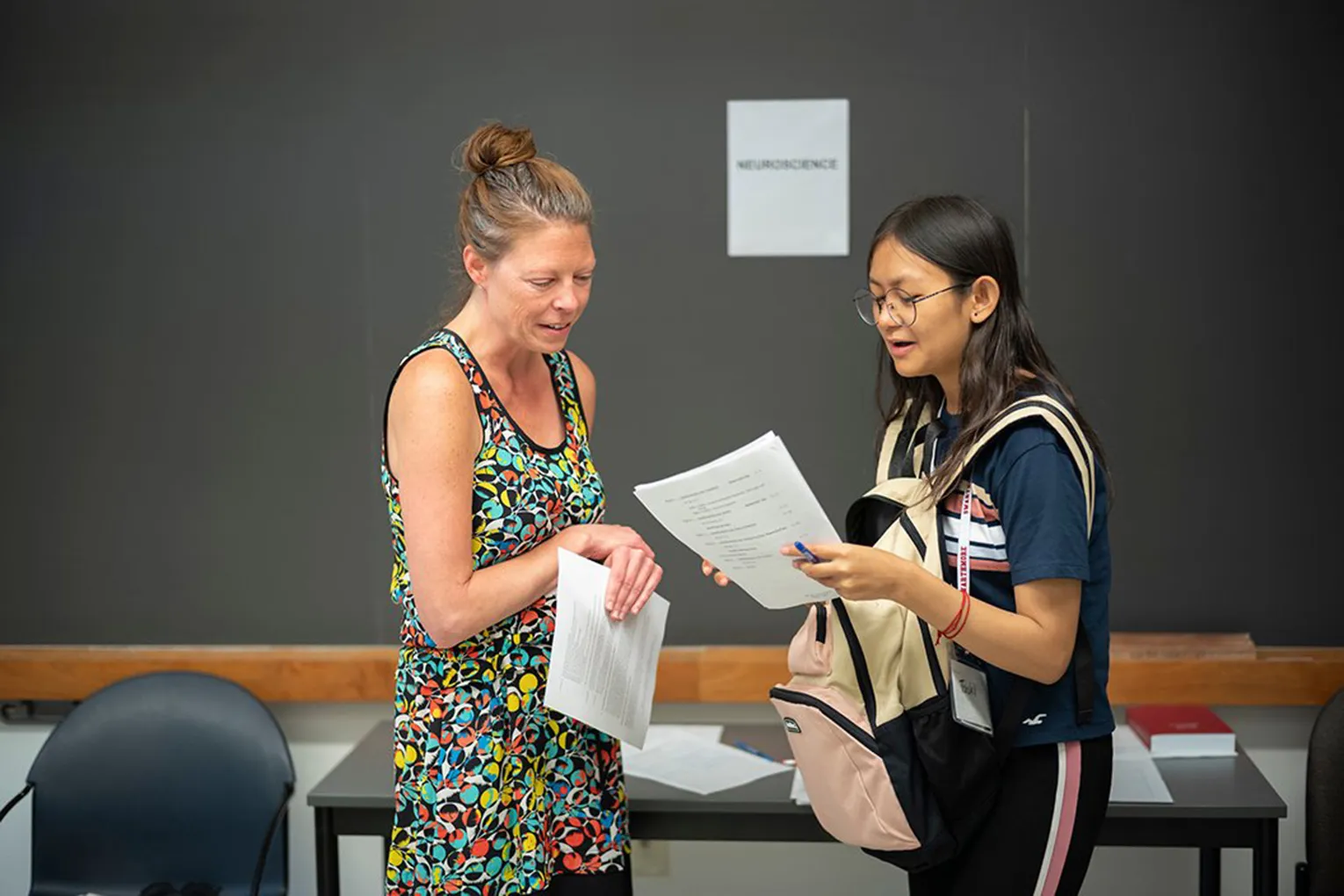Program Structure
Developed by a Swarthmore faculty and staff reading group in summer 2015, in partnership with community stakeholders, Swarthmore's internal Carbon Charge consists of three components.
- Internal Carbon Fee
To make the real costs of carbon emissions visible, foster a sense of collective responsibility for mitigating climate change, and generate revenue for sustainability projects, the College levies a carbon fee on each department for the costs of Swarthmore's annual carbon emissions.
In 2015, Swarthmore was responsible for approximately 12,500 metric tons of CO2 equivalent of greenhouse gas from our heat generation and purchased electricity. The Board of Managers approved an annual charge of $300,000, which is levied on each office and department as a flat percentage of their total budgets, excluding salaries and benefits. The amount of the total fee is regularly updated based on new emissions and budget data. Annually, a number of offices and departments generously contribute additional funds, bringing our campus charge close to the estimated social cost of carbon and providing us with greater resources to undertake emissions reductions projects.
The revenues collected through the fee contribute to the Carbon Charge Fund, which is overseen by the Carbon Charge Working Group. Read more about the use of the fund below.
- Air Travel Carbon Fee
As the College works to achieve carbon neutrality by 2035, it is critical to account for the indirect emissions from air travel which made up about 16.5% of the College’s total greenhouse gas emissions in FY2024. To address the climate impact of air travel, the College has adopted an air travel carbon fee, effective July 1, 2022.
This fee builds upon the existing carbon charge program to further address campus emissions trends while continuing to support off-campus study and official travel opportunities. The air travel carbon fee is automatically levied on department operating budgets at the beginning of each fiscal year, so no action is required from individual staff and faculty. In order to align with the College’s budgeting cycle, the charge for each fiscal year will be based on flights purchased between January 1 and December 31 of the previous calendar year (i.e. the FY2026 charge is based on flights taken during 2023). Read more about how the data is used and the fee is levied in this Overview for Financial Managers.
The fee is currently set at $11 per flight itinerary, meaning that one round-trip ticket will incur a fee of $11, regardless of how many individual flights are taken within that itinerary. The fee structure was developed through careful consideration of the price of carbon used to levy our existing carbon fee ($26.24/MTCDE) and the average amount of emissions per flight itinerary based on our 2019 GHG inventory (0.41 MTCDE). It is supported through research done by the Office of Sustainability in coordination with two President’s Sustainability Research Fellows, that included a review of best practices at other institutions.As outlined in the College’s annual Greenhouse Gas Inventory, air travel falls into a category of emissions known as Scope 3, or emissions that are not directly controlled or mitigated by the College. Innovative carbon pricing strategies such as the air travel carbon fee offer a pathway to address these emissions. Funds generated by this fee are intended to be used by the College in two primary ways: (1) to neutralize Scope 3 emissions through carbon offsets (as part of this effort, the Office of Sustainability is working to develop a long-term carbon offset policy and strategy that focuses on high-quality verified offsets) and (2) to support initiatives that reduce the College’s Scope 3 emissions as much as possible.
Although the fee will be levied at the beginning of the fiscal year in order to appropriately apply the funds to emissions initiatives described above, regular reports will be sent to financial managers with the total number of flights and projected fees for the upcoming fiscal year, for transparency and to encourage additional consideration of travel patterns. Given the reduced travel in recent years due to the pandemic, the fee structure will continue to be evaluated and improved to support the College's carbon neutrality goals.
- Shadow Price
Constructing or renovating campus spaces requires many decisions based on thoughtful cost-benefit analysis. The use of a shadow price on carbon provides a framework for incorporating the negative impacts of Swarthmore’s carbon emissions, both on and off campus, into these cost-benefit analyses.
In 2016, the College established a shadow price of $100 per metric ton of CO2e emitted. In 2025, the Carbon Charge Working Group (CCWG) evaluated different pathways to update the shadow price and ultimately decided to align with Second Nature's Carbon Markets Guidance that sets a sector-wide price for higher education. The College's current shadow price is set at $210 with escalation rates added for inflation and marginal damages of carbon emissions, which will be reevaluated every few years by the CCWG.
With a shadow price, the College makes decisions as though we would have to pay $210 per metric ton of CO2e emitted. To implement this tool, Swarthmore uses a life cycle cost analysis calculator that accounts for the cumulative emissions of the project. You can access the most recent version of Swarthmore's life cycle cost analysis calculator here.
For example, if the College is constructing a new building, the project team may consider heating the building either with ground source heat pumps or with natural gas boilers. The graph below demonstrates how a shadow price would find that a ground source heat pump is a less expensive option because it takes into account the social cost of carbon.

For more information on the shadow price, review Developing Swarthmore College’s Shadow Price on Carbon, a case study in Second Nature’s Internal Carbon Pricing in Higher Education Toolkit.
- Use of Carbon Charge Revenues
Allocated by the Carbon Charge Working Group, the Carbon Charge Fund supports renewable energy, efficiency upgrades, improved metering, emission reductions, and education initiatives. In 2019-20, the Carbon Charge raised slightly more than $300,000, allocated to the following categories:
- $200,000 for energy saving projects through the Green Revolving Fund
- $90,000 for research, analysis, strategic planning, and metering
- $10,000 for education, engagement, and learning opportunities
The Green Revolving Fund
2016-17 President’s Sustainability Research Fellow Aaron Metheny ‘18 worked with the Carbon Charge Committee and Ecosphere Executive Committee to develop Swarthmore’s Green Revolving Fund, which uses a model popularized by the Sustainable Endowments Institute.
Swarthmore’s Green Revolving Fund is a self-renewing pool of capital that grants loans to energy projects on campus. As the energy projects reduce utility expenses, the savings are returned to the revolving fund until the “loan” is paid off, which replenishes the fund for further projects. The project loans are managed through the Green Revolving Investment Tracking System. Examples of past and current projects include steam pipe insulation improvements and LED lighting upgrades for the Lamb-Miller Fieldhouse, Tarble Pavilion, and Science Center.
Research, Analysis, and Strategic Planning
The Carbon Charge Committee values an informed approach to emissions reduction, utility planning, renovations, and resilience. The Carbon Charge Fund has been used to support projects such as the development of To Zero By Thirty-Five, electricity meter installations in several campus buildings, and consulting support to solicit project bids for an off-site, utility-scale renewable energy project.
Education, Engagement, and Behavior Change
The committee also collaborates with groups on campus to raise awareness and understanding of carbon pricing on campus and in the higher education community. For example, these funds have been used to fund a delegation for the People’s Climate March and a pilot project, as part of the President’s Sustainability Research Fellowship, to install devices to measure and reduce electricity consumption from outlets in several campus buildings.
Leadership and Recognition
Beyond Swarthmore's campus, we are also working to educate our broader community about carbon pricing policy solutions, collaborating with other institutions about internal carbon pricing programs, and lending Swarthmore's public voice to supporting a price on carbon.
- Collaboration with Other Institutions
Swarthmore is among a small group of schools with internal carbon prices. For example, Yale University is piloting structures for an internal carbon price to find the most effective policy for emissions reduction at a university. Vassar College incorporates a shadow price and robust life cycle cost analysis policy into its decision making.
Together, we are working to share the lessons and best practices learned on our campus and help other institutions institute carbon pricing and replicate a shadow price in their institutional context. Swarthmore is a leading contributor to the Internal Carbon Pricing in Higher Education Toolkit, which provides guides, case studies, and resources to institutions looking to build new internal carbon pricing programs. The Toolkit launched at the 2018 Global Climate Action Summit with an address from Former Secretary of State John Kerry.
Swarthmore is also a member of the Carbon Pricing Leadership Coalition, which brings together leaders from government, the private sector, academia, and civil society to expand the evidence base for the most effective carbon pricing systems and policies. President Smith contributed a commentary to their 2018-19 annual report.
- Advocating for a Price on Carbon
In Fall 2016, Swarthmore President Valerie Smith was the second signatory of the Put A Price On It campaign's letter calling on elected leaders to take action on carbon pricing. She stated:
“As leaders of higher education institutions, we call upon our elected representatives to act collectively on behalf of current and future generations by putting a price on carbon. We work to prepare our students for thriving futures, over which climate change casts a dark shadow of uncertainty. Putting a price on carbon pollution is an indispensable step we can take to effectively combat climate change.”
Would you like to learn more? Read the full letter here. To learn more about why President Smith chose to sign on, click here.
- Awards
Swarthmore was honored to receive a 2017 Sustainable Campus Excellence Award in the Innovative Collaboration category from the International Sustainable Campus Network (ISCN) for developing our Carbon Charge program and helping to design tools for how to implement a carbon charge in other institutions.
In 2019, Swarthmore was recognized with an Excellence in Sustainability Award from the National Association of College and University Business Officers for our leadership in carbon pricing.
Questions?
Reach out to the Office of Sustainability with any questions, comments, feedback or concerns at sustainability@swarthmore.edu.



